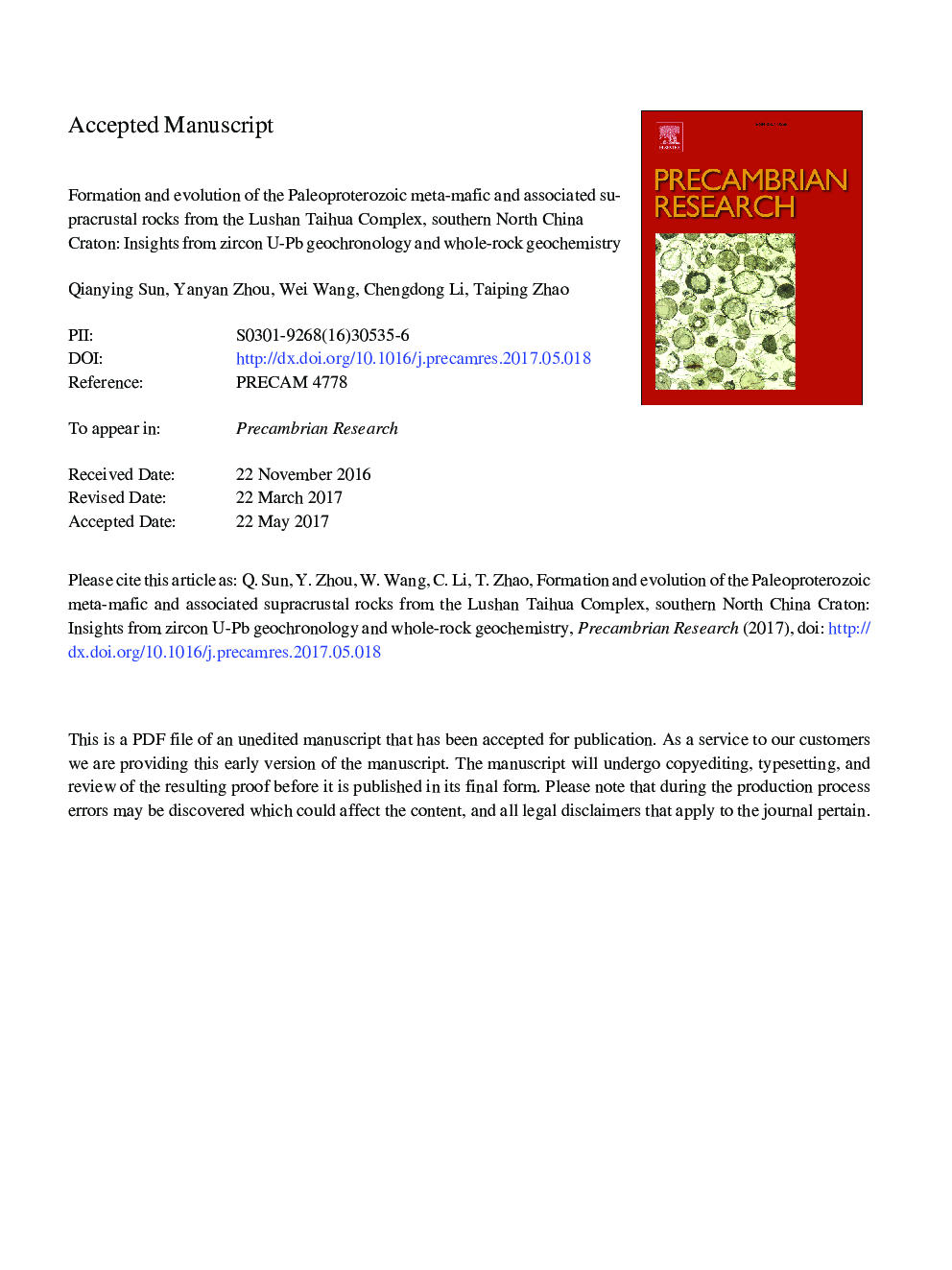| کد مقاله | کد نشریه | سال انتشار | مقاله انگلیسی | نسخه تمام متن |
|---|---|---|---|---|
| 8912741 | 1639572 | 2017 | 63 صفحه PDF | دانلود رایگان |
عنوان انگلیسی مقاله ISI
Formation and evolution of the Paleoproterozoic meta-mafic and associated supracrustal rocks from the Lushan Taihua Complex, southern North China Craton: Insights from zircon U-Pb geochronology and whole-rock geochemistry
دانلود مقاله + سفارش ترجمه
دانلود مقاله ISI انگلیسی
رایگان برای ایرانیان
کلمات کلیدی
موضوعات مرتبط
مهندسی و علوم پایه
علوم زمین و سیارات
ژئوشیمی و پترولوژی
پیش نمایش صفحه اول مقاله

چکیده انگلیسی
The Upper Taihua Complex in the Lushan area is one of the best preserved Paleoproterozoic metamorphic basements exposed in the southern North China Craton, which is mainly composed of Khondalite-dominated supracrustal rocks and associated meta-mafic intrusions (amphibolites) and granitic plutons. Detrital zircon U-Pb ages of four paragneisses from the supracrustal rocks can be divided into two groups: 2.39-2.10 Ga and 1.97-1.83 Ga. Concordant 207Pb/206Pb ages from the older group show typical magmatic features with a distinct peak around 2.31-2.23 Ga, whereas the metamorphic zircons define a remarkable age peak at â¼1.93 Ga. Magmatic zircons from the amphibolite sample have a weighted mean 207Pb/206Pb age of 2128 ± 29 Ma, representing the crystallization age of the protolith. Therefore, the depositional age of the supracrustal rocks in the Upper Taihua Complex can be well constrained at â¼2.23-2.13 Ga. Geochemically, the amphibolites are classified as subalkaline high-Fe tholeiitic basalts in compositions and characterized by slightly enrichment in LREE, flat HREE and weakly negative Eu anomalies, with depleted high field strength elements (e.g., Nb, Ta, and Ti), inconsistent with typical rocks derived from the asthenospheric mantle. The high FeOT (>13.59 wt%), CaO (>6.67 wt%), low Al2O3 (<13.09 wt%), Th (<3.09 ppm), and lack of correlation between εNd (t) values and crustal contamination sensitive elements suggest that crustal assimilation was limited during magma evolution. The varied εNd (t) values (â2.99 to +0.44) and Nd model ages (2.65-2.98 Ga) suggest that they were likely originated from Archean subcontinental lithospheric mantle (SCLM) which have been refertilized by metasomatic processes. These geochronological and geochemical signatures indicate the meta-mafic rocks and associated supracrustal rocks of the Upper Taihua Complex in the Lushan area were most likely formed in an intra-continental rift setting, implying the extensional tectonic scenario rather than subduction-related regime occurred between â¼2.2 and 2.0 Ga at least in the southern margin of the NCC. Metamorphic ages suggest that the Taihua Complex in the Lushan area was involved in subduction-collision processes from 1.97 Ga to 1.83 Ga.
ناشر
Database: Elsevier - ScienceDirect (ساینس دایرکت)
Journal: Precambrian Research - Volume 303, December 2017, Pages 428-444
Journal: Precambrian Research - Volume 303, December 2017, Pages 428-444
نویسندگان
Qianying Sun, Yanyan Zhou, Wei Wang, Chengdong Li, Taiping Zhao,